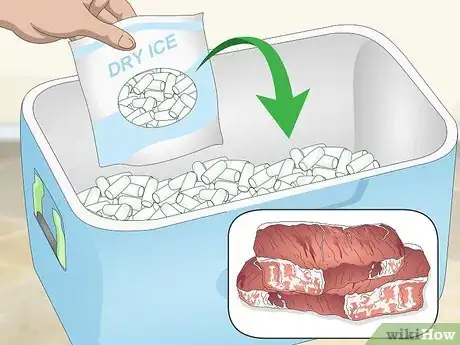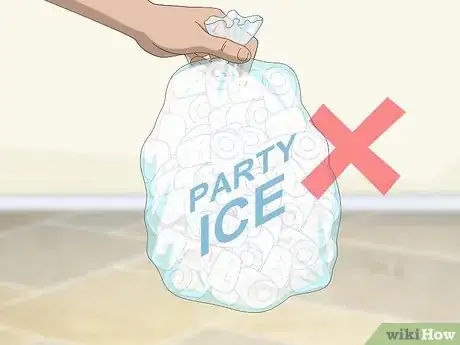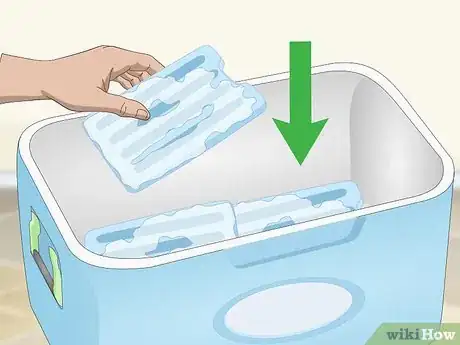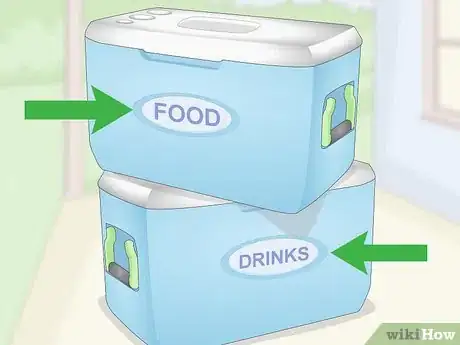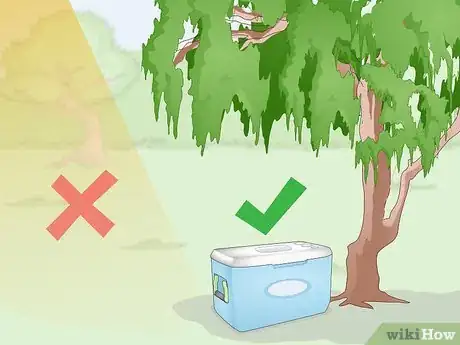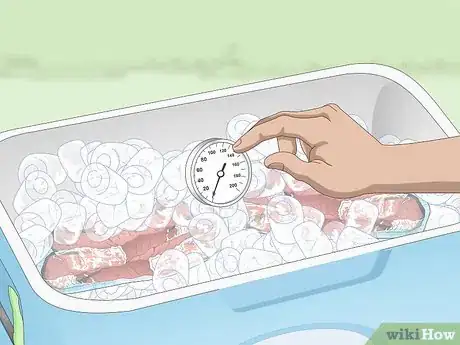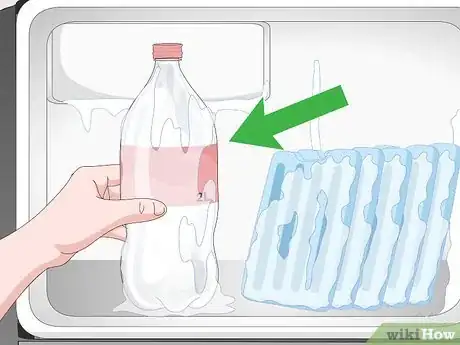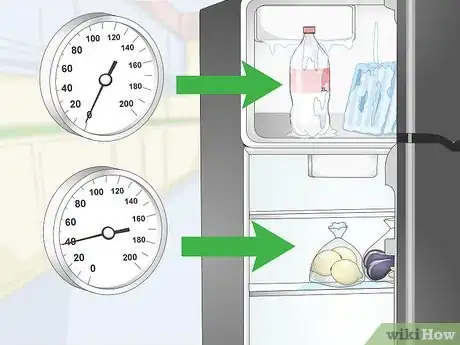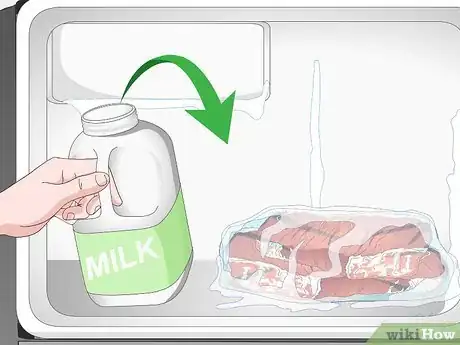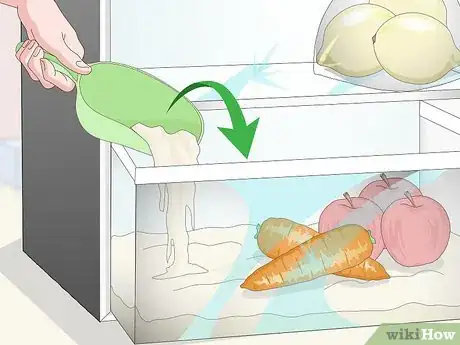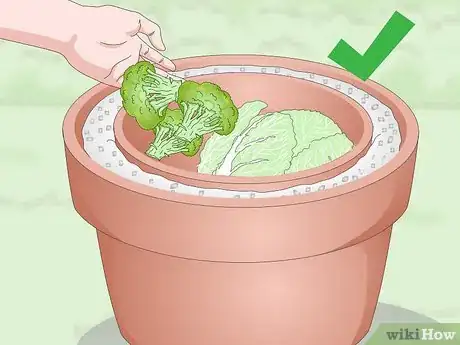This article was co-authored by Aaron Beth. Aaron Beth is the founder of Aaron’s Refrigeration Company in New York City and a factory certified installer (FCI) for Sub-Zero products. He specializes in the service and maintenance of built-in refrigerators, wine coolers and ice machines. With over 54 years of experience, Aaron is the recipient of numerous Super-Service awards from Angie’s Lists and 2019 Best-of-the City.
This article has been viewed 38,213 times.
Whether you're heading out on a camping trip and want to enjoy your favorite on-the-go meals or the power in your home is temporarily out, everyone needs to keep food cold at some point. You have a few different options available to you, including the classic cooler that have become a staple for camping trips and some more creative ideas for the times when you need to cool your food without a working refrigerator.
Steps
Storing Food in a Cooler
-
1Choose a cooler made from insulation material suited to your needs. Styrofoam coolers are the cheapest and lightest, although also less effective than other options. Plastic and metal are the next step up, with the former great for camping trips and the latter sturdy enough for fishers and hunters. Electric coolers are the most expensive, but eliminate the need for ice.
- Purchase a cooler that works with dry ice for greater flexibility.
-
2Purchase dry ice for meat items that need to be frozen. Dry ice is composed of carbon dioxide and is colder than standard ice (an average of around 109.3 °F (42.9 °C)). It also doesn't liquefy as it gets warm, which makes for a cleaner cooler. Insulate your dry ice with cardboard or newspaper before layering it into your cooler, and always keep some dry ice on the top to maximize cooling.
- Dry ice only works with approved dry ice coolers.
Advertisement -
3Avoid using the bags of party ice sold at supermarkets. Although these bags are cheap and accessible, they melt faster than other forms of ice due to their brittle nature.[1]
- Reserve party ice for topping up your cooler last-minute or keeping your food cold for 1 to 2 days at most.
-
4Freeze water in 2 litres (2,000 ml) containers a week prior to your trip. Keep containers in your freezer until the day you leave. Prior to leaving, add them into your coolers to help keep their temperature low.[2]
- You can also defrost these juice containers over the course of 1 to 2 days for cold and clean drinking water.
-
5Place thermal ice packs in your cooler the night prior to your trip. Doing this will ensure that when you pack all of your food the next morning, it will be going straight into a cold environment, as opposed to one that starts off warm.[3]
- Pre-cooling helps the temperatures of your food slay lower for longer periods of time.
- Always use thermal ice packs as opposed to bagged ice. They come in many shapes, sizes, and price ranges, and are reusable.
-
6Bring 2 coolers and designate one for food and one for drinks. Opening your cooler all the time to get drinks will compromise the quality of food stored in it. With one cooler designed for food, you can minimize the amount of cold air that escapes.[4]
- Some cooler brands are specifically designed for food.
-
7Layer your cooler in rows and keep frozen foods at the bottom. Begin by placing your ice at the bottom of the cooler, followed by frozen foods and raw meats. Continue to alternate between layers of ice and food, working your way up to the items that need the least amount of refrigeration, such as fresh fruits and vegetables. Top off your cooler with a layer of ice.[5]
- Items closer to the lid will be exposed to the air most frequently and experience the most temperature increases when you open the lid.
-
8Keep your cooler in locations with plenty of shade. Always avoid exposing your cooler to higher temperatures. During the summer when weather is warm, cover it with a blanket or tarp as well.
- Keep moving your cooler throughout the day to make sure it’s always covered by shade.
-
9Monitor your cooler's temperature using an appliance thermometer. Appliance thermometers (the ones you can buy for your fridge and freezer) can be used to monitor cooler temperature. Meats should be kept in a cooler with a temperature of 0 °F (−18 °C) or below, while anything you would keep in your refrigerator should be in an environment that is 40 °F (4 °C) or below.[6]
- Discard perishable food (poultry, meat, eggs, leftovers) that is stored above 40 °F (4 °C) for a period of 2 hours or more.
Cooling without a Working Refrigerator
-
1Create a collection of freezer packs and ice in your freezer. Always keep some space for ice cubes and freezer packs for situations like power outages that can put your food at risk.
- Block or dry ice is ideal for keeping your freezer cold for longer periods. Approximately 50 pounds (23 kg) of dry ice can maintain a fully stocked freezer 18 cubic feet (0.509703 cubic meters) in size within the safe zone for 2 days.
-
2Freeze 2 litre (2,000 ml) juice containers full of water for emergencies. When a power outage hits, you can use them to keep food at proper temperatures in your refrigerator, freezer, and coolers. You can also thaw them for clean, cold drinking water.[7]
-
3Monitor the temperatures in your freezer and refrigerator. Regularly check their temperatures using appliance thermometers to ensure that your freezer is 0 °F (−18 °C) or below, and your refrigerator is 40 °F (4 °C) or below.[8]
- Appliance thermometers will help you determine the foods that are still safe to eat.
- Throw away perishable food (meat, eggs, poultry, leftovers) that is stored above 40 °F (4 °C) for 2 hours or more.
-
4Store refrigerated items that you don’t need immediately in the freezer. Items like milk, fresh poultry and meat, and leftovers are at the highest risk of spoiling in the fridge. Always make sure to store them in the freezer right when the power goes out to maintain safe temperatures for as long as possible.[9]
- Group these items close together to maintain lower temperatures through contact.
-
5Fill your crisper drawer with sand to keep root vegetables fresh. Purchase sand from your local hardware store and fill your crisper with it. This is a great way to keep root vegetables and fruits fresh by minimizing the moisture that usually rots them.[10]
- Root vegetables and fruits include carrots, apples, pears, and beets.
-
6Create a pot-in-a-pot refrigerator for a cheap form of solar cooling. These cost-effective pot-in-a-pot fridges are very simple to make, requiring only a few pots, sand, and water. By keeping the sand moist with water, evaporation cools vegetables and drinks.
- Use water from your melted ice or juice containers to keep sand moist.
- Pot-in-a-pot refrigerators don't work in high humidity levels because evaporation is minimal in these kinds of environments.
Expert Q&A
Did you know you can get expert answers for this article?
Unlock expert answers by supporting wikiHow
-
QuestionHow can I make a dying refrigerator colder?
 Aaron BethAaron Beth is the founder of Aaron’s Refrigeration Company in New York City and a factory certified installer (FCI) for Sub-Zero products. He specializes in the service and maintenance of built-in refrigerators, wine coolers and ice machines. With over 54 years of experience, Aaron is the recipient of numerous Super-Service awards from Angie’s Lists and 2019 Best-of-the City.
Aaron BethAaron Beth is the founder of Aaron’s Refrigeration Company in New York City and a factory certified installer (FCI) for Sub-Zero products. He specializes in the service and maintenance of built-in refrigerators, wine coolers and ice machines. With over 54 years of experience, Aaron is the recipient of numerous Super-Service awards from Angie’s Lists and 2019 Best-of-the City.
Appliance Technician You can try turning the temperature gauges up all the way if they aren't already. Most fridges have two gauges: one for the fridge and one for the freezer. Turn the fridge gauge up all the way to see if you can keep your food cold for a little longer while you're waiting for a service technician to show up.
You can try turning the temperature gauges up all the way if they aren't already. Most fridges have two gauges: one for the fridge and one for the freezer. Turn the fridge gauge up all the way to see if you can keep your food cold for a little longer while you're waiting for a service technician to show up. -
QuestionWhat's the coldest spot in the refrigerator?
 Aaron BethAaron Beth is the founder of Aaron’s Refrigeration Company in New York City and a factory certified installer (FCI) for Sub-Zero products. He specializes in the service and maintenance of built-in refrigerators, wine coolers and ice machines. With over 54 years of experience, Aaron is the recipient of numerous Super-Service awards from Angie’s Lists and 2019 Best-of-the City.
Aaron BethAaron Beth is the founder of Aaron’s Refrigeration Company in New York City and a factory certified installer (FCI) for Sub-Zero products. He specializes in the service and maintenance of built-in refrigerators, wine coolers and ice machines. With over 54 years of experience, Aaron is the recipient of numerous Super-Service awards from Angie’s Lists and 2019 Best-of-the City.
Appliance Technician
-
QuestionWhat are two ways of keeping things hot?
 Maggie PetersonCommunity AnswerKeep food in the oven at a low temperature and place food in a covered dish, then place dish in an 8x8 (or larger, if needed) glass baking dish filled hallway with hot water.
Maggie PetersonCommunity AnswerKeep food in the oven at a low temperature and place food in a covered dish, then place dish in an 8x8 (or larger, if needed) glass baking dish filled hallway with hot water.
Things You'll Need
Storing Food in a Cooler
- 2 litres (2,000 ml) juice containers
- 2 coolers
- Thermal ice packs
- Ice
- Dry ice
- Blanket or tarp
- Appliance thermometer
Keeping Food Cool during Power Outages
- 2 appliance thermometers
- 2 litres (2,000 ml) juice containers
- Sand
- Freezer packs
- Ice cubes
- Block or dry ice
- Two clay (terracotta) pots, unglazed, one larger than the other
- Appliance thermometer
- Sand
- Water
- Cloth to cover the pots
- Clay, cork or other material to plug holes in pots (if they have them)
Warnings
- Food-borne bacteria grows within temperature ranges from 41 to 140 °F (5 to 60 °C), which is known as the danger zone.⧼thumbs_response⧽
- Your freezer should be at 41 °F (5 °C) or below, and your freezer at 0 °F (−18 °C).[11]⧼thumbs_response⧽
References
- ↑ http://www.gocampingaustralia.com/10-tips-to-keep-food-cold.html
- ↑ http://www.gocampingaustralia.com/10-tips-to-keep-food-cold.html
- ↑ http://www.gocampingaustralia.com/10-tips-to-keep-food-cold.html
- ↑ http://www.gocampingaustralia.com/10-tips-to-keep-food-cold.html
- ↑ http://www.gocampingaustralia.com/10-tips-to-keep-food-cold.html
- ↑ https://www.foodsafety.gov/blog/poweroutage2013.html
- ↑ https://www.quickanddirtytips.com/house-home/food/how-to-keep-drinks-cold-without-a-cooler
- ↑ https://www.foodsafety.gov/blog/poweroutage2013.html
- ↑ https://www.quickanddirtytips.com/house-home/food/how-to-keep-drinks-cold-without-a-cooler

